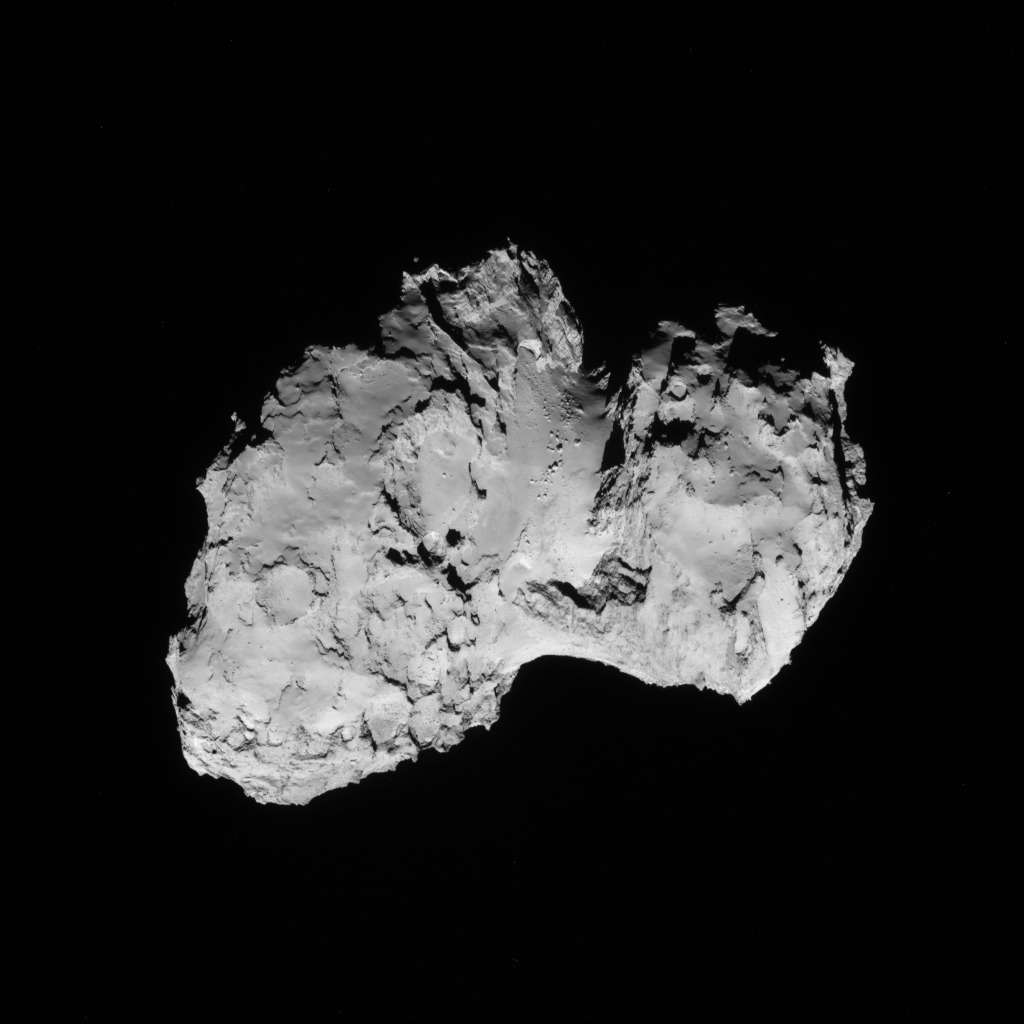Rosetta navigation camera (NAVCAM) image taken on 19 August 2014 at a distance of about 79 km from comet 67P/C-G.
CometWatch – 19 August
- access_time 20/08/2014
- chat_bubble_outline 22 comments
Written by
emily
access_time
20 August 2014
chat_bubble_outline
22 comments
format_list_bulleted
Ambition the film

Click image to watch Ambition
Read Rosetta: the ambition to turn science fiction into science fact
Mission milestones
| Event | Date |
| Launch | 2 Mar 2004 |
| Earth swingby | 4 Mar 2005 |
| Mars swingby | 25 Feb 2007 |
| ... more | |









Discussion: 22 comments
Thanks again for the nice photo. The shadows
allow to estimate the heights of certain
“features”.
Would it be possible that the Philea landing team gives the public a typical size of the anticipated landing ellipse, then we can join in the hunt for a good landing spot using all the pictures that have been released to date. Should be fun, let’s see who comes closest to the eventual choice by the experts.
Can’t wait to see when the comet becomes active.
Can we get more of those stereo double-photos? Those are incredibly revealing of heights and depths.
This comet no longer looks to me like two objects cemented together; looks more like one object that has been severely scooped out.
I think we are beginning to see layered strata that has been separated at some point and then reformed
Will a 3D model be shared ? I would enjoy manipulating it in a 3D software to see the Comet in detail. Thanks for all your amazing work.
Most stereo overlaps are 40%, that is 40% of the 1st picture is included in the 2nd picture. This gives a good image showing an enhanced height effect.
I am not sure that the rotating Comet will give a satisfactory pair of images as it is not only rotating but tumbling as well which would give lateral shift of the images.
The 1st pair taken from a distance were fine giving a good stereo image but the 2nd lot were not so good as the edges of the pics. were fuzzy due to the tumbling effect. I found I could only focus on the top of the escarpment to get good stereo vision. Maybe some parts of the object were moving faster than the rest due to the motion of the Comet.
We just need more Stereo pairs with good time seperation.
Clive
You will be able to see my house soon. I will wave when Rosetta ‘on tops’. Question…ESA, do you expect to see any of the primary colours at all and if so, which hue?
Stunning photography. Thanks for sharing.
Hi Emily,
Many thanks to you and your colleagues for taking the time to post from your other responsibilities. Don’t forget that for every response you see here, there are probably 50,000 other lurkers you don’t hear from who also appreciate ypur postings!
– Steve
Thank you!
Could the cavity neck be the result of coma erosion due to concentrated thermal radiation at the base of reflective canyon walls?
I think the comet is almost coaldark.
So, reflected light should play only a minor
role, at least in the currnt state.
Just my 2 cent.
Have we got a good estimate for the mass yet? What is it?
It’s something that the teams are currently working on.
What is the closest the spacecraft will ever be to the comet and when?
The plan is to get within 10 km of the comet, maybe closer. This animation describes the spacecraft’s trajectory over the next couple of months, in case you did not see it yet: https://www.youtube.com/watch?v=Mf1zsACcXc4
Will Philae be released at 10km or do you intend getting closer still?
In ESA announcemet 10km are given as a plan.
However, at the very end of the mission, the
team might try a soft landing of Rosetta itself.
As the comet travels away from the Sun the solar panels will eventually not provide enough power for operations. A landing should be feasible. Avoiding getting blasted back into orbit from venting gases may be a problem though. I probably seem to be a know all but I dare to dream.
I forget the orbital return date however, can Rosetta survive, once again, the frigid realms of the outer solar system long enough to be brought back to life when she feels the warmth from dear old Sol.
As Elton John says in the song Rocket Man ‘it’s lonely in outer space on such a timeless flight’.
Interresting idea: Rosetta landing on 67P 🙂
But what i think would be really cool:
Rosetta maintaining a stable orbit around 67P, following the comet (mostly in hibernation) on it’s trajectory until it once again get’s close enough to the sun (in 5-6 years) for Rosetta to wake up once again.
If Rosetta would manage this and still be operational, we could see if anything has changed on 67P while it was “away”, and make a detailed comparison between the two sun-approaches of 67P.
…but i’m afraid that would a bit to much to ask, even for Rosetta
I am one of the 50,000 lurkers lol, just want to say I am absolutely in awe of you guys and the work that the team at ESA has done so far, it is absolutely gripping, as a lay person, looking at these fab pictures and reading all the manoeuvres that you can do with Rosetta, good luck in finding a spot to land the Philae lander and looking forward to lots more fantastic pictures of the comet and possibly the tail up close.